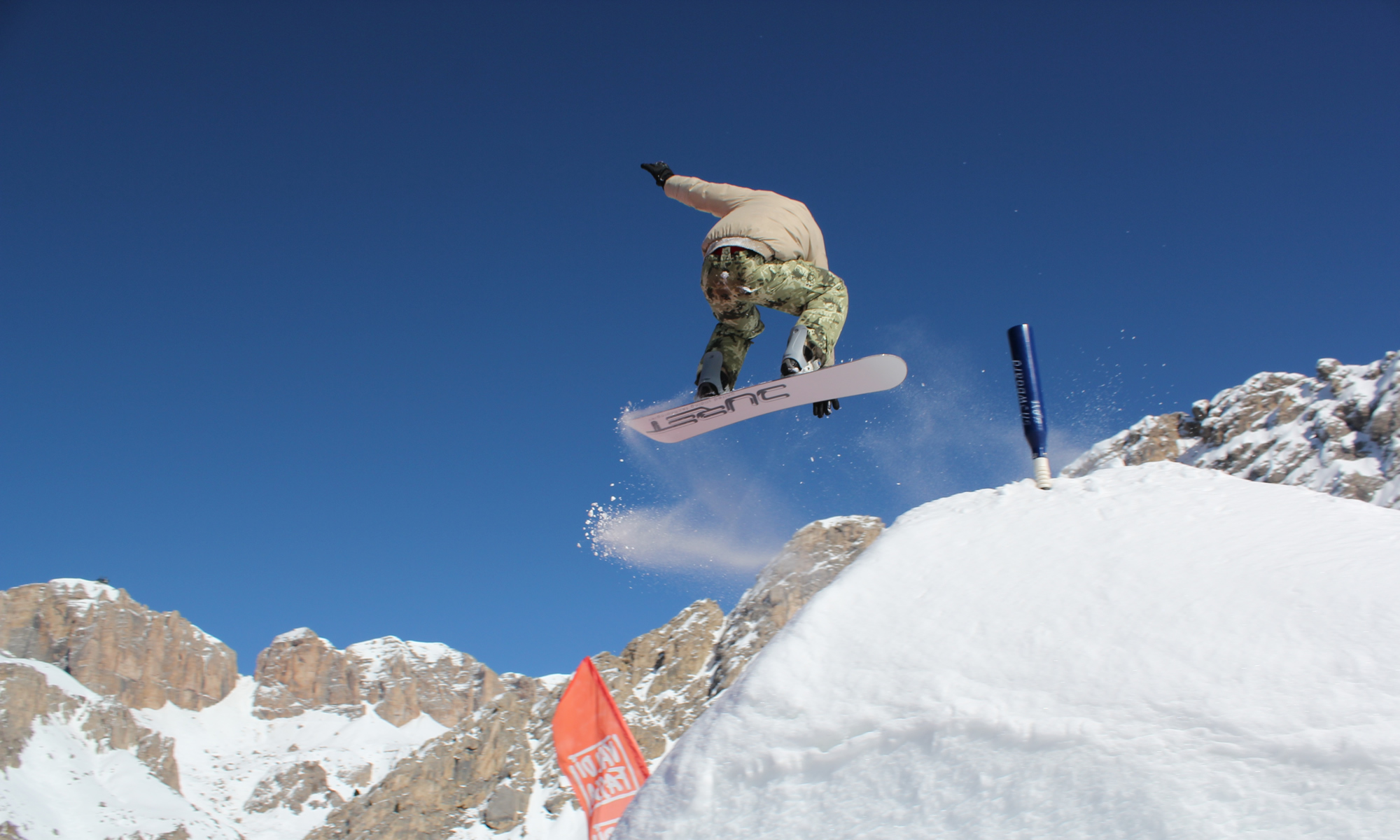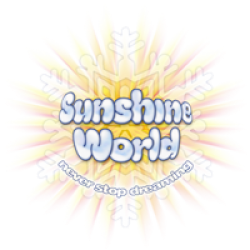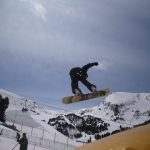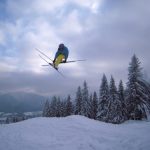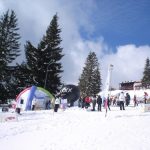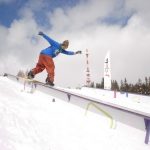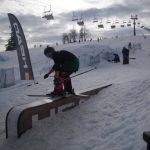Snowparks and Freestyle Skiing in Zakopane
Zakopane has always been perfectly suited to freestyle snowboarders. There are so many easily accessible little hills which you can drive right up to, park up and start hiking the jumps and rails immediately without having to mission all the way up a mountain to get to the park. Even in the best resorts in the world like Whistler Blackcomb you have to take at least 30 minutes worth of chair or bubble lifts before you can get to the parks and let’s face it, sometimes you just want to be able to spend an hour playing around, practice, take some photos and video and then hit the hot tub! In Zakopane you can do just that with minimum in between time. There’s even an awesome terrain park on Gubalowka with brand new rails and boxes which you can get to at the bottom of the main street, Krupowki!
DUAL SNOWBOARDS – GETTING STARTED
Set Up
Deck: have the Dual logos facing each other on your in step.
Base: Have the DU AL positioned so that when you walk or run up the hill, your friends see DU AL (not AL DU). The bottom of the word DU AL is your toe edge and the top is your heel edge.
0-15 Degrees outwards on each binding (Most use 15 degrees out on each foot, but some people use no angle – feel it out to get the best stance for yourself)
Strap in, run up the slope and start shredding!
Walking / Running
When walking or running up the slope, keep your feet a little wider apart than u sual to avoid inner edges knocking together.
Dig the toe edges in for stability as you walk or run up the slope.
Riding
Once ready to go, head down the hill in your normal riding position keeping knees slightly bent. As you get momentum, turn your head and shoulders in the direction you want to turn and your hips and body will follow.
To come to a stable stop, turn your shoulders so that you turn onto your toe edge. Ride up onto the rail to slow and stop as you face the slope – similar to how you would on a snowboard.
TIP: While feeling them out, you are more stable on your toe edge, so if you start to feel like you are picking up too much speed at first, just turn onto your toe edge, and apply pressure to come to a stop.
TIP: The first session on Dual boards will work a muscle group on your back leg’s inner thigh that you have not used much before. So after a while on your first day you may feel fatigued in that muscle area. The next day this fatigue will be less, then the next day practically gone – like returning to gym after a long time – a few workouts and the stiffness leaves you training stronger, with less and then no more fatigue.
1st Tricks
SPINS: Even a novice will find it surprisingly easy to do grounded spins on the Duals once comfortable, as the rails are so much shorter than a traditional board or skis, so they turn tighter and are less likely to catch your edge. Start to turn, then as you approach completion of the rotation of 180 or 360 degrees, steer the back foot outwards (like a rudder) to reverse the rotation until you are riding in a straight line again.
BOXES: Ride onto the box (or start at the top of the box from a stationary position) going down in a straight line, while looking at the end of the box (do not look down at your feet). When you land off the box, with knees bent, stomp your feet down to secure the landing and turn onto your toe edge for stability and reduce speed. Your legs may want to spread apart as you land so keep pressure using your thigh muscles to keep them together.
180 or 360 Kickers: Start with a small kicker / ramp. As you get to the top of the kicker, jump and twist to spin into the 180 or 360 degree rotation. Start by looking in the direction that you want to spin, your shoulders will follow along with your hips, followed by the boards. Stomp the landing down with knees bent a little and turn onto your toe edge for stability and to reduce speed.
These are just some pointers to get you going on your first few runs, or tricks in the park if you are a freestyler. From there you will find the possibilities endless. You can see more of what our riders are doing at www.stickyourtrick.com
SAFETY
Freestyle snowboarding can be safe if the right rules and respect are applied when learning and practicing the discipline. Major points are:
- Always wear body armour AND a helmet
- Always warm up and stretch well before practicing
- Always start SMALL and easy and gradually build up to more challenging and bigger tricks, jumps and rails.
- Whenever trying something for the first time ensure that you get professional coaching and go through the correct teaching progression to ensure that you build up the necessary coordination BEFORE trying the full trick.
- Learn and respect “Park Etiquette” and the skiiers code (below)
For more information about Freestyle skiing we recommend visiting Wikipedia’s page on the topic. at: www.en.wikipedia.org/wiki/Freestyle_skiing
The FIS (International Ski Federation) has established ten rules for the conduct of skiers and snowboarders. They are to ensure safety on the slopes and are governed by law.
In short, they are:
Respect
Do not endanger others.
Control
Adapt the manner and speed of your skiing to your ability and to the general conditions on the mountain.
Choice of route
The skier/snowboarder in front (furthest DOWNHILL) has priority – leave enough space.
Overtaking
Leave plenty of space when overtaking a slower skier/snowboarder.
Entering and starting
Look up and down the mountain each time before starting or entering a marked run.
Stopping
Only stop at the edge of the slopes or where you can easily be seen.
Climbing
When climbing up or down, always keep to the side of the slopes.
Signs
Obey all signs and markings – they are there for your safety.
Assistance
In case of accidents provide help and alert the rescue service.
Identification
All those involved in an accident, including witnesses, should exchange names and addresses.
All the above rules are binding by law and apply to both skiers and snowboarders.
Important guidelines for skiers and snowboarders
- You ski/board at your own risk.
- Pay attention to all signs and markers.
- Please ski/board on marked runs – these are protected from unexpected alpine dangers.
- The areas outside the marked runs are called ‘off slopes’ and they are not patrolled or groomed.
- Watch out for slope preparation machines.
- Respect nature – take care not to ski in areas where young trees or wildlife will be disturbed and don’t drop litter.
- Consider taking lessons on a dry slope, and fitness sessions before going on holiday.
The above guidelines apply to all users of the marked slopes
Snowboarding slopes
Outside the marked slopes and itineraries are areas which are NOT protected from alpine dangers –
- Signs around the ski area will warn you when avalanche danger is present.
- Even when there is no warning of avalanches there could be local snow slides.
- Unless you know an area well, only ski/board on slopes with a guide.
IF IN DOUBT NEVER SKI AWAY FROM THE MARKED SKI RUNS.
